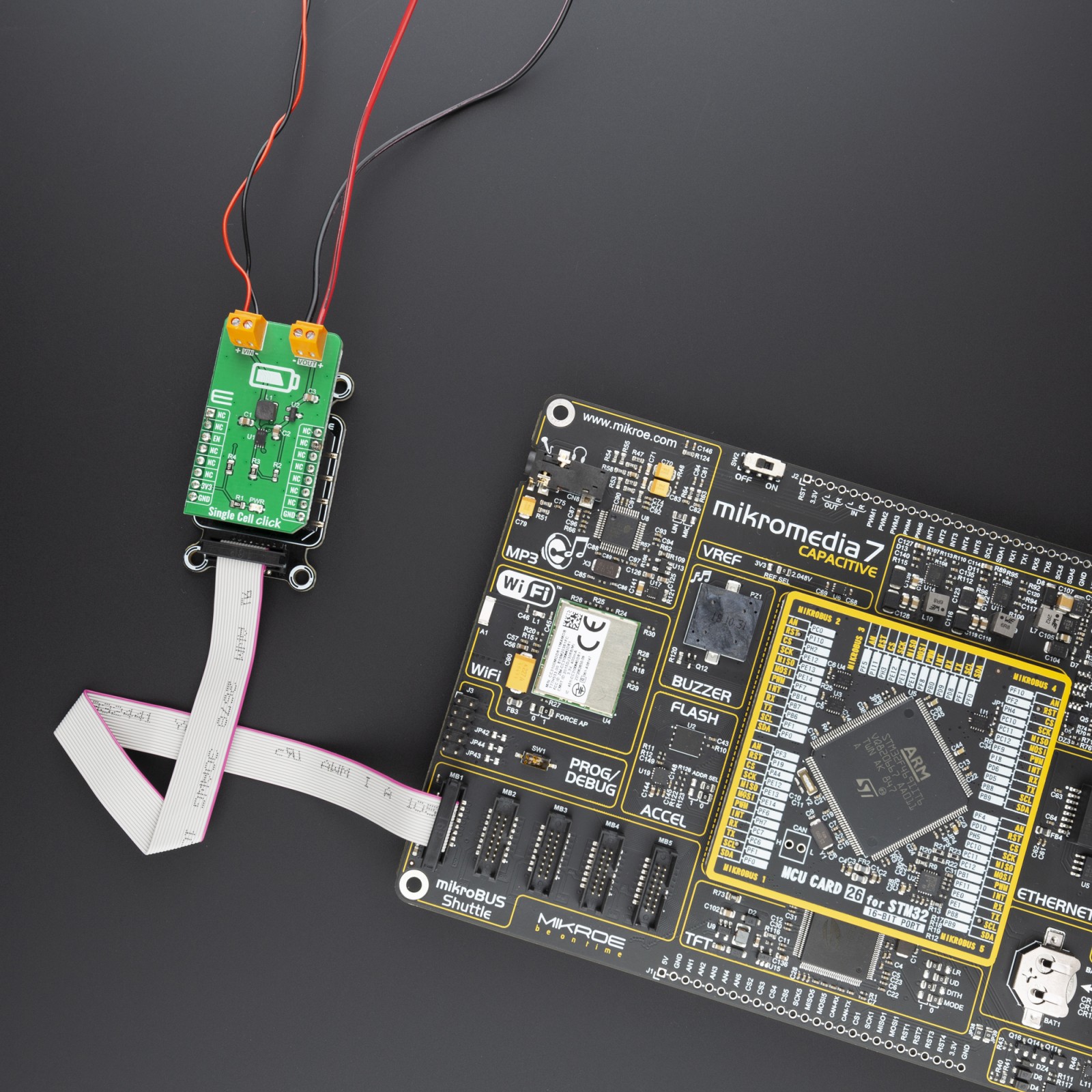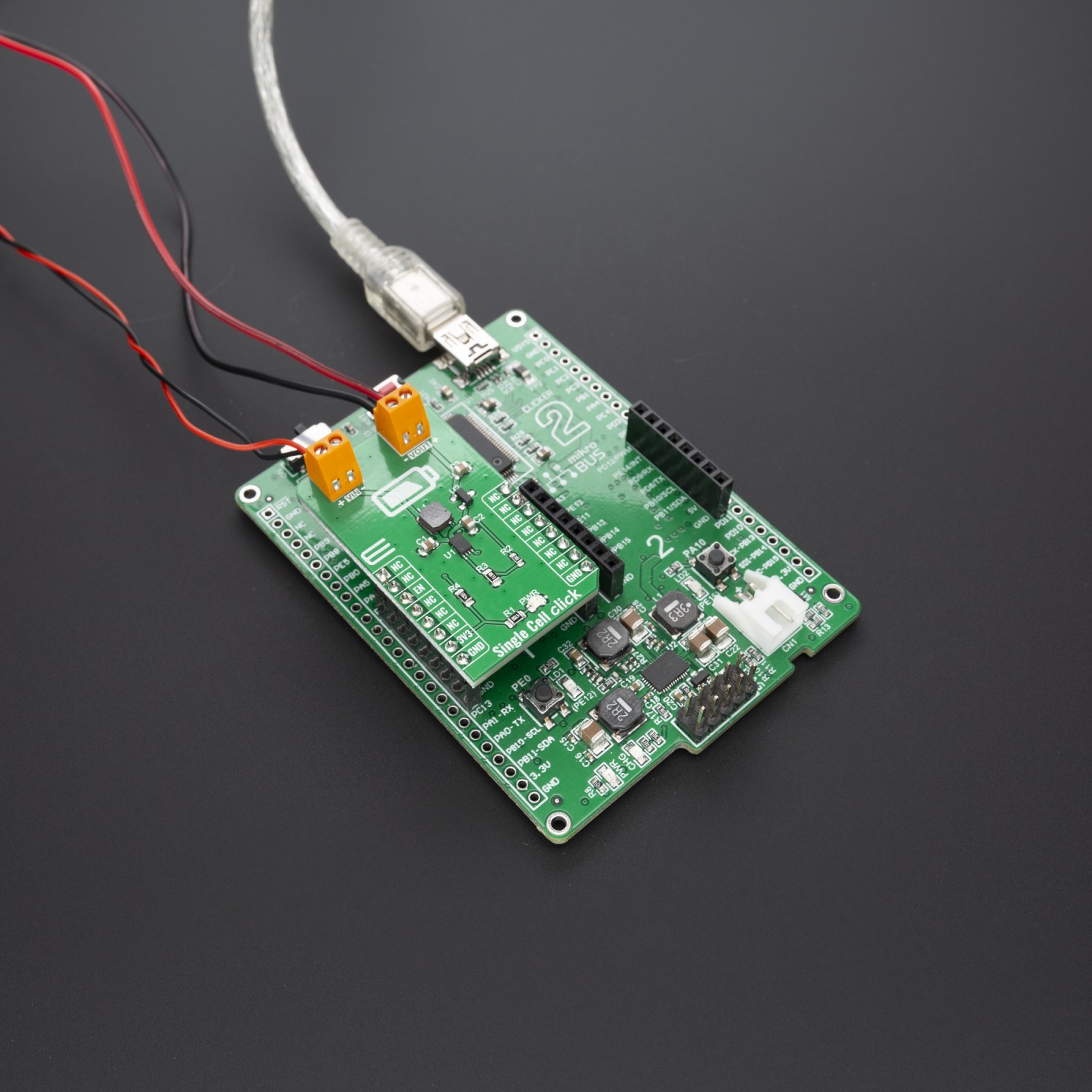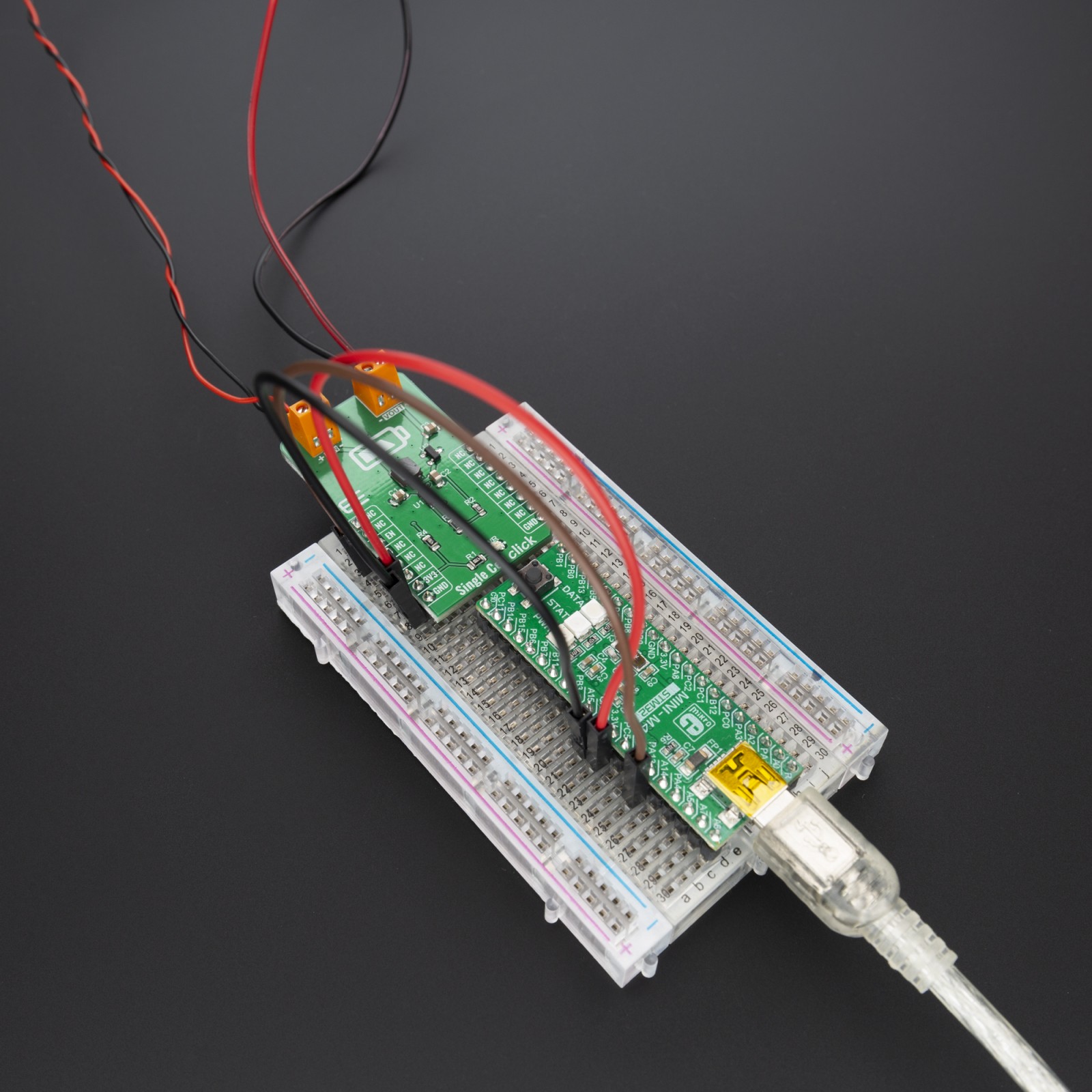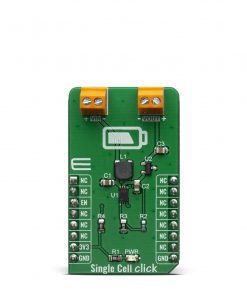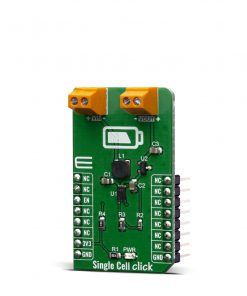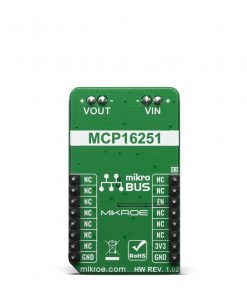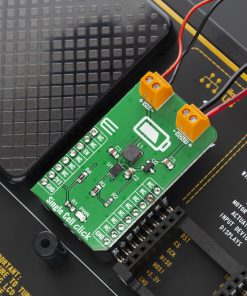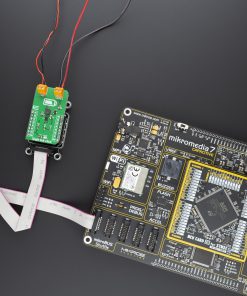Subtotal: R335.00
Single Cell Click
R205.00 ex. VAT
The Single Cell click is a Click board™ which features MCP16251 synchronous boost regulator with true load disconnect and MCP1811A low-dropout (LDO) linear regulator that provide an ultra low quiescent current during device operation of about 250nA and can be shut down for 5nA (typical) supply current draw. Given the potential applications of these features, the Single Cell click can be used for one, two and three-cell Alkaline and NiMH/NiCd portable products, solar cell applications, personal care and medical products, smartphones, MP3 players, wireless sensors and many more.
The Single Cell click is supported by a mikroSDK compliant library, which includes functions that simplify software development. This Click board™ comes as a fully tested product, ready to be used on a system equipped with the mikroBUS™ socket.
Stock: Lead-time applicable.
| 5+ | R194.75 |
| 10+ | R184.50 |
| 15+ | R174.25 |
| 20+ | R167.69 |
How does it work?
The Single Cell click is based around the MCP16251 from Microchip, a compact, high-efficiency, fixed frequency, synchronous step-up DC-DC converter. This device provides an easy-to-use power supply solution for applications powered by either one-cell, two-cell or three-cell alkaline, NiCd, NiMH, one-cell Li-Ion or Li-Polymer batteries. Low-voltage technology allows the regulator to start-up without high inrush current or output voltage overshoot from a low-voltage input. High efficiency is accomplished by integrating the low-resistance N-Channel boost switch and synchronous P-Channel switch. All compensation and protection circuitry are integrated to minimize external components. MCP16251 is paired with MCP1811A device a good choice for new ultra-long life LDO applications that have high-current demands, but require ultra-low power consumption during sleep periods.
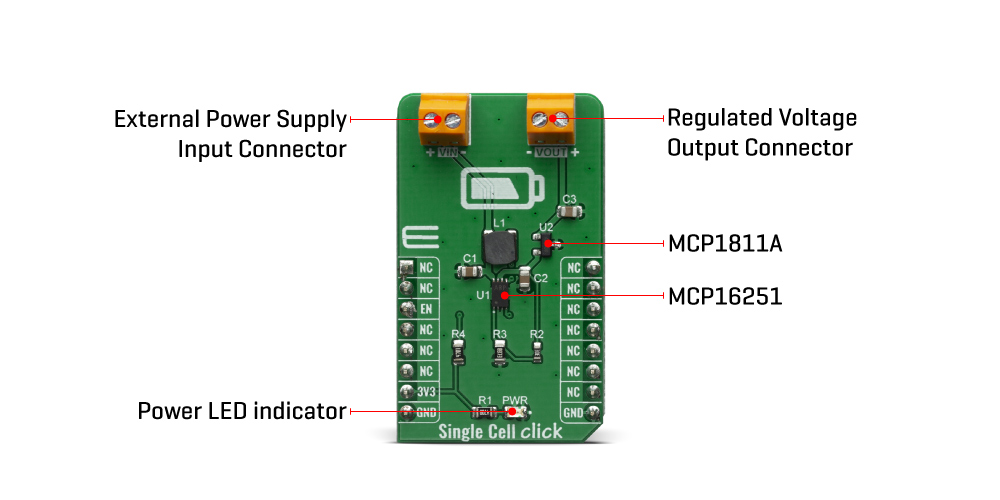
MCP16251 that’s featured on Single Cell Click operates and consumes less than 14 µA from battery after start-up, while operating at no load. The device provide a true disconnect from input to output while in shutdown EN = LOW. While in shutdown it consume les than 0.6 µA from battery.
The MCP1811A device is a 150 mA Low-Dropout (LDO) linear regulators that provide high-current and low-output voltages while maintaining an ultra-low 250 nA of quiescent current during device operation. In addition, it can be shut down for 5 nA (typical) supply current draw. The 150 mA output current capability, combined with the low output voltage capability, make the MCP1811A a good choice for new ultra-long life LDO applications that have high-current demands, but require ultra-low power consumption during sleep periods. The MCP1811A device is stable with ceramic output capacitors that inherently provide lower output noise, and reduces the size and cost of the entire regulator solution.
The Single Cell click was designed to operate with a wide input voltage range after start-up, down to 0.35V, to accommodate a large variety of input sources. When considering a primary power solution for a design, the battery type and load current needs must be carefully selected. The MCP16251 start-up voltage is typical 0.82V at 1 mA load but this does not act as an UVLO start-up threshold. The device starts draining current to bias its internal circuitry before the 0.82V input and cannot start-up or operate well with high-impedance sources because their voltage varies in time, from zero to over 0.82V (i.e., energy harvesting). Start-up voltage is the point where the device starts switching in closed loop and the output is regulated and depends on load and temperature.
Batteries are available in a variety of sizes and chemistries and can support a variety of drain rates. No matter the chemistry, most batteries have several things in common. They should not be drained below their specified FEP (Functional End Point or Cut-Off Voltage). Below this point, if the battery has a load applied to it, there will not be enough energy to deliver power because all usable capacity is used. For an alkaline cell, FEP is 0.9V or 0.8V. Using the alkaline cell below the FEP will increase the risk of leakage. There is an exception for alkaline batteries: if the battery voltage is strictly monitored, it can be drained down to 0.5V in one-cell applications only. For a rechargeable NiMH cell, the FEP value is usually 1.0V – 1.1V.
Another particular situation is powering a boost circuit from one rechargeable cell like NiMH or NiCd. These applications need an external MCU to monitor the cell voltage or a separate UVLO circuit to prevent deep discharging, which results in permanent cell damage. In a multi-cell powered application (e.g., 2.4V typ. from two NiMH cells) deep discharging will result in a reverse polarity charging of one of the cells due the unbalanced cell voltages, thus damaging the respective cell.
Specifications
Type
Boost,Linear
Applications
Solar cell applications, personal care and medical products, smartphones, MP3 players, wireless sensors and many more
On-board modules
MCP16251 boost and the MCP1811A LDO
Key Features
High-efficiency, Low-voltage input
Interface
GPIO
Feature
No ClickID
Compatibility
mikroBUS™
Click board size
M (42.9 x 25.4 mm)
Input Voltage
3.3V
Pinout diagram
This table shows how the pinout on Single Cell click corresponds to the pinout on the mikroBUS™ socket (the latter shown in the two middle columns).
Onboard settings and indicators
| Label | Name | Default | Description |
|---|---|---|---|
| PWR | LED GREEN | – | Power LED Indicator |
| VIN | – | – | External Power Supply Input Connector |
| VOUT | - | – | Regulated Voltage Output Connector |
Software Support
We provide a library for the Single Cell Click on our LibStock page, as well as a demo application (example), developed using MikroElektronika compilers. The demo can run on all the main MikroElektronika development boards.
Library Description
The library covers all the necessary functions to control Single Cell Click board. The library contains a function which enable or disable the regulator output switching.
Key functions:
void singlecell_enable()– Enable the regulator output function.void singlecell_disable()– Disable the regulator output function.
Examples description
The application is composed of three sections :
- System Initialization – Initializes GPIO and LOG structures, set CS pin as output and start write log.
- Application Initialization – Initialization driver enable’s – GPIO, also write log.
- Application Task – (code snippet) This is a example which demonstrates the use of Single Cell board. This example shows the automatic control of the Single Cell click, waits for valid user input and executes functions based on set of valid commands. Results are being sent to the Usart Terminal where you can track their changes. All data logs on usb uart for aproximetly every 1 sec when the data value changes.
- Commands :’E’ – Enable regulator output; ‘D’ – Disable regulator output;
void applicationTask()
{
char receivedData;
if ( UART_Rdy_Ptr() )
{
receivedData = UART_Rd_Ptr();
switch ( receivedData )
{
case 'E' :
{
singlecell_enable();
mikrobus_logWrite( " Enable regulator output ", _LOG_LINE );
mikrobus_logWrite( "-------------------------", _LOG_LINE );
break;
}
case 'D' :
{
singlecell_disable();
mikrobus_logWrite( " Disable regulator output", _LOG_LINE );
mikrobus_logWrite( "-------------------------", _LOG_LINE );
break;
}
}
}
}
The full application code, and ready to use projects can be found on our LibStock page.
Other mikroE Libraries used in the example:
- UART
Additional notes and informations
Depending on the development board you are using, you may need USB UART click, USB UART 2 click or RS232 click to connect to your PC, for development systems with no UART to USB interface available on the board. The terminal available in all MikroElektronika compilers, or any other terminal application of your choice, can be used to read the message.
mikroSDK
This Click board™ is supported with mikroSDK – MikroElektronika Software Development Kit. To ensure proper operation of mikroSDK compliant Click board™ demo applications, mikroSDK should be downloaded from the LibStock and installed for the compiler you are using.
For more information about mikroSDK, visit the official page.
Resources
Downloads
| Weight | 20 g |
|---|---|
| Brand | MikroElektronika |

 METHANE Click
METHANE Click 



